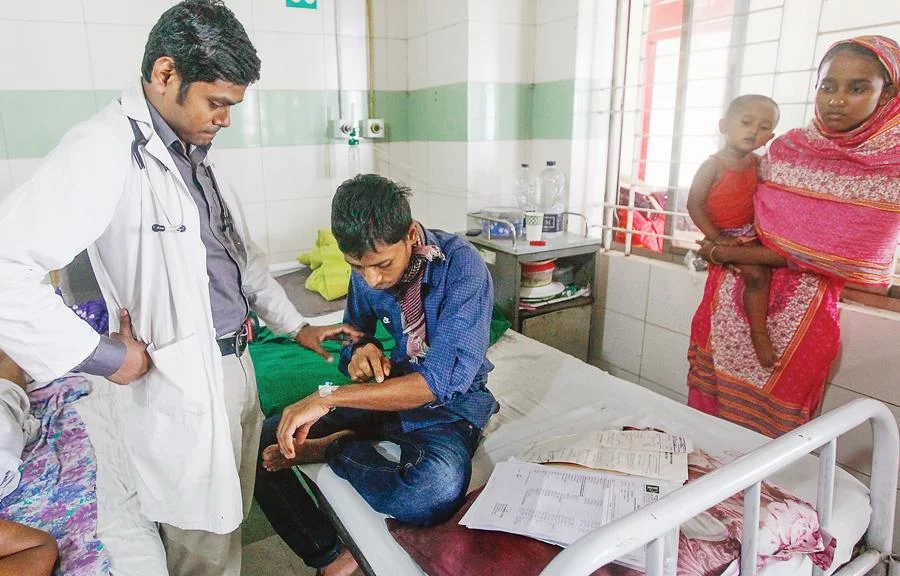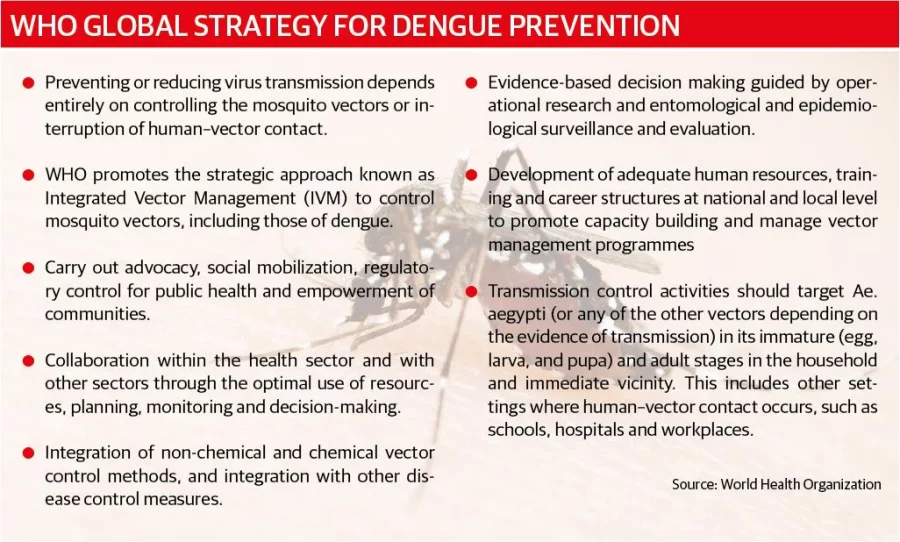Last year, the World Health Organization (WHO) predicted that Bangladesh was at risk from an outbreak of chikungunya, a mosquito-borne virus that shares many common symptoms with dengue.
Bangladesh, in a bid to mitigate the outbreak of dengue, signed on to the World Health Organization’s Global Strategy for Dengue Prevention and Control last year, which also covers measures against the spread of Chikunguniya.
The Dhaka Tribune has found that a lack of coordination and knowledge about this global prevention strategy has left all government bodies concerned shifting the blame between each other, leaving the virus to spread almost at will.
Director of the Institute of Epidemiology Disease Control and Research (IEDCR), Prof Dr Meerjady Sabrina Flora said they had predicted this outbreak a year ago and warned the concerned government agencies to prepare for it.
She told the Dhaka Tribune that the IEDCR was following the WHO guidelines and has for a year been presenting seminars with representatives of public and private organisations including that of the city corporations to prevent this outbreak.
However, officials at the Dhaka City Corporations, which are in charge of controlling the Aedes mosquito, that spreads both chikungunya and dengue, said they were not aware of the WHO Strategy for Dengue Prevention and Control that was adopted by the government.

An on-duty doctor is talking to a patient diagnosed with Chikungunya at Dhaka Medical College Hospital
Mehedi HasanProf Samia Tahmina, director (Disease Control) of the Directorate General of Health Services told the Dhaka Tribune that following adoption of the WHO strategy, the Directorate gave instructions to the relevant agencies to take action.
This guideline for the prevention and control of chikungunya fever (CF) is intended to be used by all peripheral health workers in the region and is focused mainly on preventing, predicting and detecting outbreaks.
The six components of the regional strategy are: strengthening surveillance system for prediction, preparedness, early detection and response to chikungunya outbreaks, improvement in early case detection and case management of chikungunya fever, integrated vector management (IVM), social mobilization and communication, partnerships and operational research.
Usually, the city corporation’s concerned department sprays insecticides every five days, to control all types of mosquitoes including the Aedes variety. However, recently we have increased that to spraying every three days
Prof Dr Flora of IEDCR said the first known case of chikungunya happened in 2008. This year they have detected some 706 cases so far. Independent experts say the actual number of people affected could be in the tens of thousands.
The World Health Organization declined to comment for this story.
Government officials have denied responsibility for the spread of chikunguniya in DhakaAdditional Secretary (PH and WHO) of the Ministry of Health and Family Welfare, Rukhsana Kader said she was unaware of the WHO prevention strategy and referred the Dhaka Tribune to her personal secretary who was also unaware of the adoption of the strategy in 2016.
Dhaka North City Corporation (DNCC) Mayor Annisul Huq on Friday said that the city corporations are not to blame for the spread of chikungunya in Dhaka, while experts claimed the mosquito-borne disease had turned into an epidemic.
Speaking at a press conference organised at the DNCC headquarters in Gulshan 2, Mayor Annisul Huq said: “Usually, the city corporation’s concerned department sprays insecticides every five days, to control all types of mosquitoes including the Aedes variety. However, recently we have increased that to spraying every three days.”
CEO of DNCC Mesbahul Islam said disease control is not the job of the city corporations, adding: “The Dhaka North City is big area to manage and there are a lot of things that the DNCC does. There is a health department that might be aware of the WHO strategy and how to mitigate this chikungunya issue.”

However, DNCC Chief Health Officer, Brig Gen Dr S M M Saleh Bhuiyan said they had not received a directive from the Health Ministry or any other government bodies regarding the WHO guidelines.
“If they knew this was going to turn into an epidemic then why did they not take actions earlier? They should have begun with the vector control mechanism. We are not aware or equipped to do that.
“We also do not know about their surveillance report on vector borne viral disease,” he said.
The vector for Chikungunya is the Aedes Aegypti mosquito which breeds in still water in urban areas. Vector surveillance during pre-monsoon and during the monsoon, if done appropriately, will provide an early warning indicator prior to the outbreak of chikungunya. Vector control can be done through anti-adult and anti-larval control of mosquitoes.
According to data collected from Bangabandhu Sheikh Mujib Medical University (BSMMU), thousands of cases of chikunguniya have been treated at the hospital this year.
Experts said vector-borne viral diseases affect a country in 4 to 5 year cycles.
Annual Report: Communicable Disease Control Bangladesh 2012, says, Chikungunya fever (CKGF), a dengue like disease, is emerging alarmingly in Bangladesh in recent years. It is a mosquito borne virus, from the genus Alpha virus. In the recent past, there were two outbreaks in Rajshahi and Pabna districts of Bangladesh. In 2011 suspected chikungunya fever outbreaks was detected in Dohar upazila of Dhaka district and Shibganj upazila of Chapainawabganj district in August. No fatality was observed during that time. The disease does not claim mortality but persistent arthralgia may lead to patient’s sufferings. Diagnosis of CKGF is important to screen the suspected cases with dengue.
 An on-duty doctor is talking to a patient diagnosed with Chikungunya at Dhaka Medical College Hospital Mehedi HasanProf Samia Tahmina, director (Disease Control) of the Directorate General of Health Services told the Dhaka Tribune that following adoption of the WHO strategy, the Directorate gave instructions to the relevant agencies to take action.
This guideline for the prevention and control of chikungunya fever (CF) is intended to be used by all peripheral health workers in the region and is focused mainly on preventing, predicting and detecting outbreaks.
The six components of the regional strategy are: strengthening surveillance system for prediction, preparedness, early detection and response to chikungunya outbreaks, improvement in early case detection and case management of chikungunya fever, integrated vector management (IVM), social mobilization and communication, partnerships and operational research.
An on-duty doctor is talking to a patient diagnosed with Chikungunya at Dhaka Medical College Hospital Mehedi HasanProf Samia Tahmina, director (Disease Control) of the Directorate General of Health Services told the Dhaka Tribune that following adoption of the WHO strategy, the Directorate gave instructions to the relevant agencies to take action.
This guideline for the prevention and control of chikungunya fever (CF) is intended to be used by all peripheral health workers in the region and is focused mainly on preventing, predicting and detecting outbreaks.
The six components of the regional strategy are: strengthening surveillance system for prediction, preparedness, early detection and response to chikungunya outbreaks, improvement in early case detection and case management of chikungunya fever, integrated vector management (IVM), social mobilization and communication, partnerships and operational research. However, DNCC Chief Health Officer, Brig Gen Dr S M M Saleh Bhuiyan said they had not received a directive from the Health Ministry or any other government bodies regarding the WHO guidelines.
“If they knew this was going to turn into an epidemic then why did they not take actions earlier? They should have begun with the vector control mechanism. We are not aware or equipped to do that.
“We also do not know about their surveillance report on vector borne viral disease,” he said.
The vector for Chikungunya is the Aedes Aegypti mosquito which breeds in still water in urban areas. Vector surveillance during pre-monsoon and during the monsoon, if done appropriately, will provide an early warning indicator prior to the outbreak of chikungunya. Vector control can be done through anti-adult and anti-larval control of mosquitoes.
According to data collected from Bangabandhu Sheikh Mujib Medical University (BSMMU), thousands of cases of chikunguniya have been treated at the hospital this year.
Experts said vector-borne viral diseases affect a country in 4 to 5 year cycles.
Annual Report: Communicable Disease Control Bangladesh 2012, says, Chikungunya fever (CKGF), a dengue like disease, is emerging alarmingly in Bangladesh in recent years. It is a mosquito borne virus, from the genus Alpha virus. In the recent past, there were two outbreaks in Rajshahi and Pabna districts of Bangladesh. In 2011 suspected chikungunya fever outbreaks was detected in Dohar upazila of Dhaka district and Shibganj upazila of Chapainawabganj district in August. No fatality was observed during that time. The disease does not claim mortality but persistent arthralgia may lead to patient’s sufferings. Diagnosis of CKGF is important to screen the suspected cases with dengue.
However, DNCC Chief Health Officer, Brig Gen Dr S M M Saleh Bhuiyan said they had not received a directive from the Health Ministry or any other government bodies regarding the WHO guidelines.
“If they knew this was going to turn into an epidemic then why did they not take actions earlier? They should have begun with the vector control mechanism. We are not aware or equipped to do that.
“We also do not know about their surveillance report on vector borne viral disease,” he said.
The vector for Chikungunya is the Aedes Aegypti mosquito which breeds in still water in urban areas. Vector surveillance during pre-monsoon and during the monsoon, if done appropriately, will provide an early warning indicator prior to the outbreak of chikungunya. Vector control can be done through anti-adult and anti-larval control of mosquitoes.
According to data collected from Bangabandhu Sheikh Mujib Medical University (BSMMU), thousands of cases of chikunguniya have been treated at the hospital this year.
Experts said vector-borne viral diseases affect a country in 4 to 5 year cycles.
Annual Report: Communicable Disease Control Bangladesh 2012, says, Chikungunya fever (CKGF), a dengue like disease, is emerging alarmingly in Bangladesh in recent years. It is a mosquito borne virus, from the genus Alpha virus. In the recent past, there were two outbreaks in Rajshahi and Pabna districts of Bangladesh. In 2011 suspected chikungunya fever outbreaks was detected in Dohar upazila of Dhaka district and Shibganj upazila of Chapainawabganj district in August. No fatality was observed during that time. The disease does not claim mortality but persistent arthralgia may lead to patient’s sufferings. Diagnosis of CKGF is important to screen the suspected cases with dengue.

